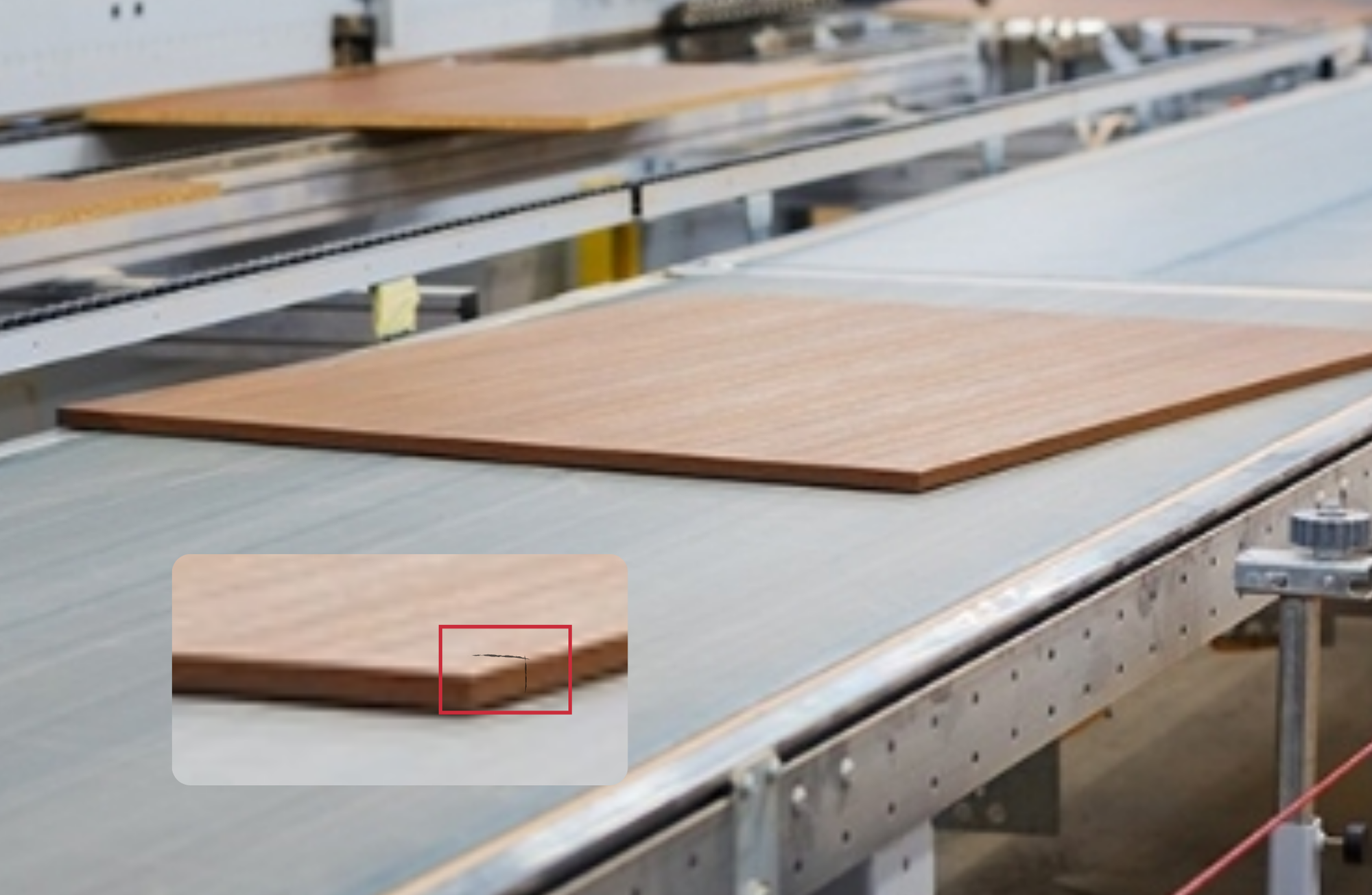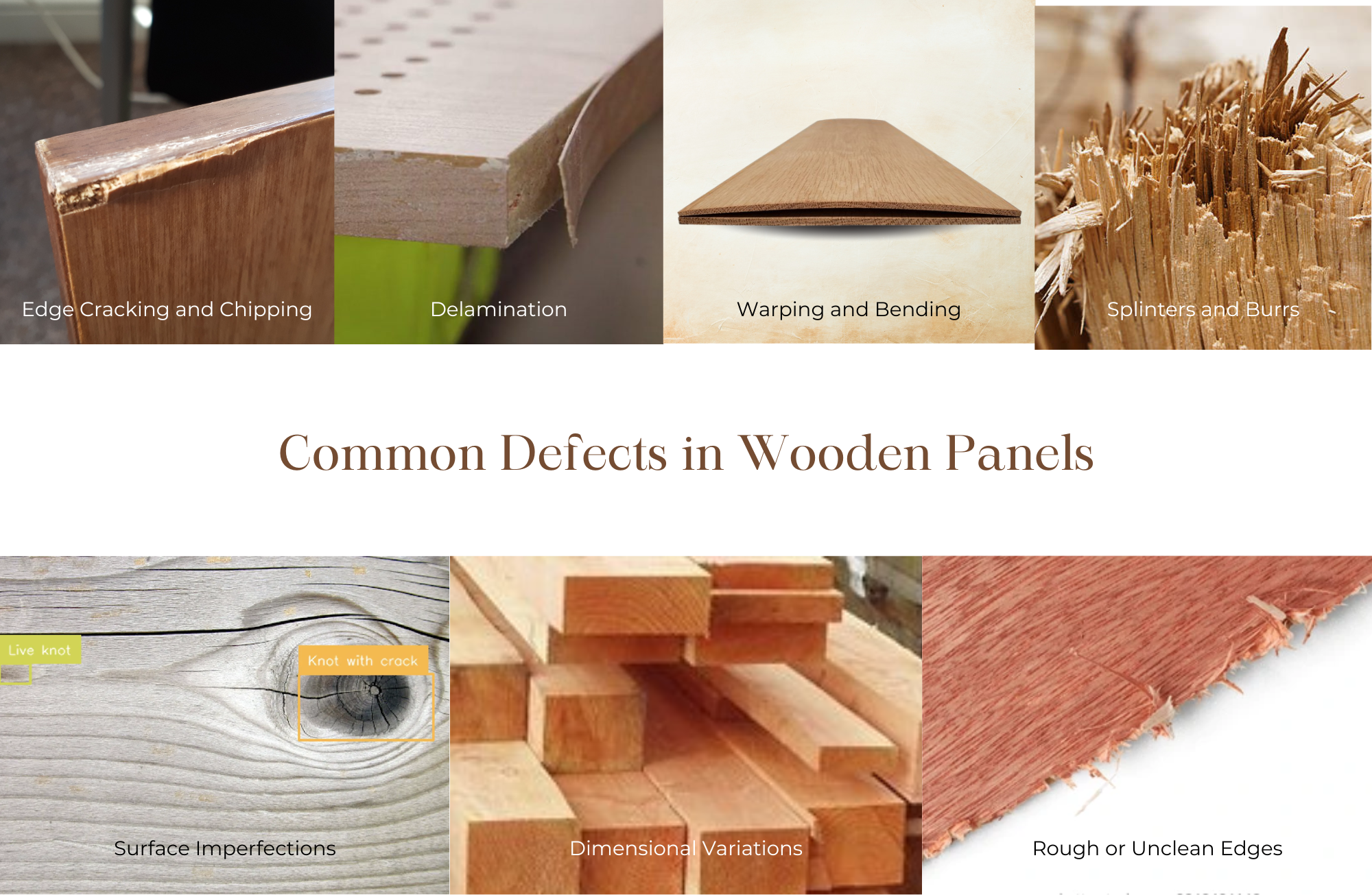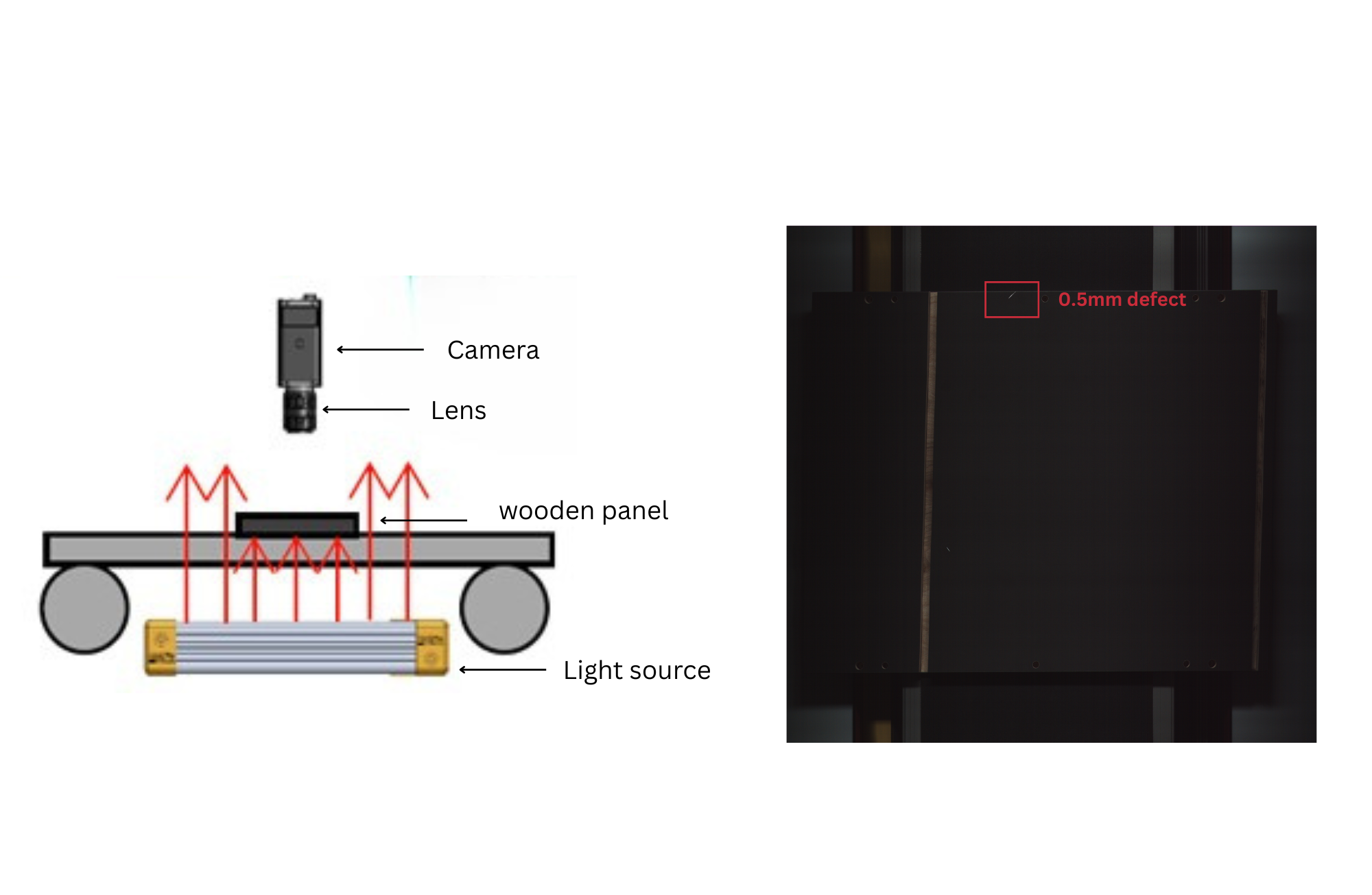Transforming Edge Detection for Wooden Panels Using Machine Vision AOI
Published on: Apr 09, 2025

Written by: Content team, Intelgic
Transforming Edge Detection for Wooden Panels Using Machine Vision AOI
In modern woodworking and panel manufacturing, edge detection is vital for maintaining product quality and ensuring precision in the production of wooden panels. With the increasing demand for high-quality wooden products across furniture, flooring, and construction industries, there is greater emphasis on precise inspection methods. Edge detection ensures that each panel aligns with design and safety standards. Traditional inspection methods struggle to cope with the demands of high-speed production and the natural variability of wood. Manual inspections, while still common, suffer from inconsistency, human error, and slow throughput. As a result, manufacturers are turning to automated systems powered by Machine Vision and Artificial Intelligence (AI) to deliver consistent, scalable, and precise inspections. This article explores the common defects in wooden panels, challenges in manual inspection, and how Machine Vision AI—particularly Intelgic’s Live Vision Software combined with line scan cameras and backlighting—is transforming edge detection automation. The study highlights key inspection parameters, system advantages, workflow, and how Intelgic has emerged as an expert in this space.

Common Defects in Wooden Panels
Wood, being a natural and variable material, introduces several potential defects during manufacturing. These include:
- Edge Cracking and Chipping: Small breaks or chips along the edge of the panel, typically caused by tool wear or cutting errors. These defects compromise structural integrity and aesthetics.
- Delamination: The separation of layers in laminated panels due to weak adhesive bonding or moisture, which results in reduced durability and failure in usage.
- Warping and Bending: Distortions caused by uneven drying or moisture retention, which make panels difficult to fit and install.
- Splinters and Burrs: Tiny projections of wood fiber or material that are not only unattractive but also unsafe, often resulting from rough cutting.
- Surface Imperfections: Knots, scratches, resin pockets, and discoloration that affect the visual appeal of panels, especially for decorative applications.
- Dimensional Variations: Deviations from specified thickness, width, or length that can affect assembly precision and lead to high material waste.
- Rough or Unclean Edges: Incomplete trimming or fiber tear-outs that affect edge quality and complicate finishing.

Challenges of Manual and Traditional Inspection
While manual inspection has been the industry standard for years, it presents significant drawbacks that impact efficiency, accuracy, and cost-effectiveness. Below are the key limitations:
- Inconsistency: Human inspection is prone to variation, fatigue, and environmental distractions, leading to uneven quality control.
- Low Throughput: Manual inspection cannot keep pace with the high-speed demands of automated production lines, creating bottlenecks.
- Missed Micro-Defects: Subtle issues like fine edge cracks or microscopic chipping are easily overlooked by the human eye.
- Lack of Digital Records: Manual processes do not leave behind data trails necessary for trend analysis, quality assurance, or compliance documentation.
- High Labor Costs: Skilled inspectors are costly and their availability can be a limiting factor.
These challenges justify the integration of automated inspection systems powered by Machine Vision.
The Role of Machine Vision in Edge Detection Automation
Machine vision systems revolutionize edge detection automation by integrating industrial-grade line scan cameras with precision lighting and AI-driven algorithms. These systems capture ultra-high-resolution images of moving panels, enabling micron-level defect detection at production line speeds. Advanced backlighting techniques create optimal contrast, revealing even sub-millimeter cracks and imperfections while ignoring irrelevant surface patterns. Sophisticated software analyzes edge profiles in real-time, comparing them against golden templates with 99.9% accuracy. This combination of hardware and intelligent software eliminates human error, ensures consistent quality, and maintains throughput speeds up to 400 FPM without compromising inspection rigor.
Key Inspection Parameters for Wooden Panels
1. Surface Defect Detection
Surface appearance is crucial, particularly in high-end applications. The system detects:
- Scratches and Abrasions: Marks from mechanical handling or tooling.
- Color Inconsistencies: Irregular stains, burn marks, or natural discoloration.
- Resin Pockets and Knots: Naturally occurring but undesirable features, especially in visible panel areas.
- Dents and Grain Disruptions: Indentations or broken wood grain patterns affecting surface integrity.
Users can fine-tune detection thresholds depending on the tolerance levels for different applications.
2. Dimensional Measurement
Precision in dimensions ensures that panels fit correctly during assembly. Live Vision measures:
- Panel Width and Length: Ensures panels meet exact design specifications.
- Thickness Consistency: Detects uneven compression or sanding.
- Corner Squareness: Identifies skew or angular deviation.
- Edge Straightness: Checks if the panel edges are uniformly cut or warped.
Measurements are made at sub-millimeter accuracy and verified in real time.
3. Golden Template Comparison
The Golden Template comparison method uses a highly accurate reference panel that represents the ideal design and specification. During inspection, each manufactured panel is digitally compared against this template using high-resolution image overlays and tolerance matching. Deviations from the golden template—such as irregular edges, dimensional mismatches, or profile shifts—are automatically flagged. This ensures strict conformity to product specifications and minimizes human error.

Transforming Edge Detection with Line Scan Cameras and Backlighting
The combination of line scan cameras and backlighting has revolutionized the accuracy of edge detection.
Working Principle:
- Line Scan Camera: Unlike area scan cameras that capture an entire image in one frame, a line scan camera captures images one line at a time as the object moves past the sensor. This enables extremely high-resolution imaging of long or continuous objects, such as wooden panels.
- Backlighting: A strong and uniform light source is placed behind the wooden panel. As the panel passes between the camera and the light source, the silhouette of its edge is cast against the bright background, producing high-contrast images that highlight even the finest edge details.
This system excels in:
- Detecting Micro-Chips and Edge Cracks: The enhanced contrast reveals the smallest irregularities in the edge profile.
- Profile Verification: Ideal for assessing complex or non-linear edge shapes for deviation.
- High-Speed Compatibility: Allows inspection at production line speeds without motion blur, ensuring consistent quality control.

Intelgic’s Live Vision Software
Once the edge profile is captured, Intelgic’s Live Vision Software steps in as the intelligent processing engine. It leverages machine learning models trained specifically on wood-based materials to interpret the high-resolution images. The software:
- Analyzes Edge Geometry: Compares edge contours against defined tolerances or the Golden Template.
- Classifies Defects: Categorizes detected imperfections by type (chip, crack, warping) and severity.
- Triggers Responses: Sends signals for accept/reject decisions and marks locations for repair.
- Logs Inspection Data: Stores comprehensive inspection records for traceability and process feedback.
Workflow of Intelgic’s Edge Detection System
Intelgic’s edge detection solution follows a streamlined, intelligent inspection workflow:
Panel Placement and Movement:
- Panels are positioned on the conveyor system, moving through the inspection area.
Image Acquisition:
- Line scan cameras, paired with backlighting, capture continuous high-resolution edge and surface data.
Image Transmission:
- The captured image data is transmitted to the computing system running Live Vision Software.
AI-Powered Processing:
- The software analyzes the data for dimensional accuracy, compares profiles to golden templates, and detects defects.
Data Processing and Analysis:
- Captured images are processed by Intelgic’s Live Vision Software, which employs AI algorithms to detect and classify defects, measure dimensions, and compare profiles against golden templates.
Real-Time Decision Making:
- Inspection results are displayed on dashboards and communicated to control systems for immediate action, such as sorting or rejecting defective panels.
Logging and Reporting:
- All inspection data is logged with timestamps and defect classifications for audit purposes and trend analysis.
Advantages of Machine Vision AOI
Intelgic’s platform offers a full-stack solution designed specifically for industrial-scale inspections. Key advantages include:
- Fast Real-Time Decision Making: Keeps up with high-speed conveyor lines without delays.
- AI Customization: Learns specific defect types and adapts models to unique production environments.
- Intuitive User Interface: Simple setup and easy navigation for operators and quality engineers.
- Modular & Scalable Design: Can be scaled from single-line systems to complex multi-line, multi-camera networks.
- Smart Analytics: Provides actionable insights into defect trends, equipment performance, and quality control efficiency.
- Seamless System Integration: Compatible with PLCs, SCADA, and MES platforms, ensuring smooth integration into existing infrastructures.
The shift from manual inspection to AI-driven edge detection marks a transformative milestone for the woodworking industry. By harnessing advanced technologies like high-resolution line scan cameras, adaptive backlighting, and Intelgic’s Live Vision Software, manufacturers now achieve unprecedented precision—detecting micron-level defects while operating at full production speeds.
As a pioneer in industrial AI, Intelgic combines cutting-edge vision technology with deep manufacturing expertise. Their platform’s adaptive learning capabilities, plug-and-play deployment, and scalable architecture make it the ideal choice for Industry 4.0-ready facilities.
With Intelgic, edge inspection evolves from a passive quality checkpoint to a competitive differentiator—driving efficiency, traceability, and customer satisfaction. This isn’t just the future of wood panel inspection; it’s the new benchmark for intelligent manufacturing.
Ready to transform your quality control? Intelgic’s Machine Vision AOI technology turns precision into profit.

